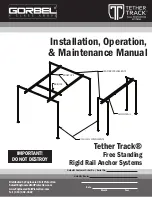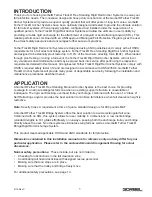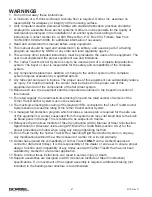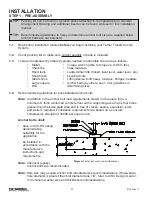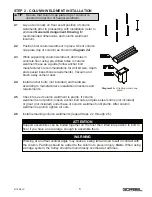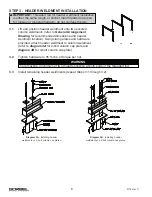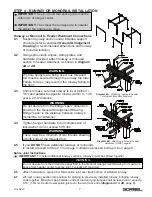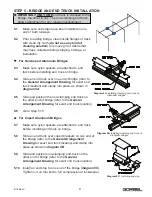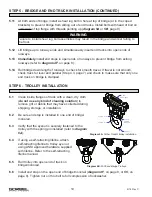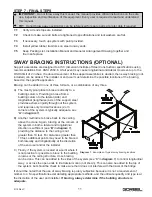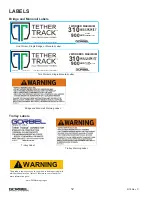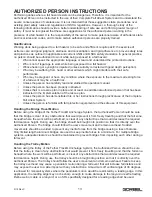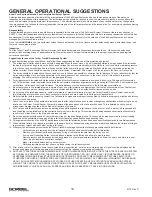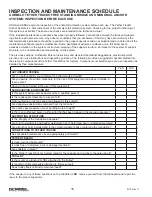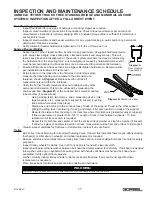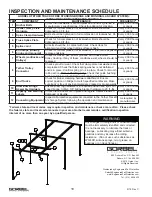
AUTHORIZED PERSON INSTRUCTIONS
Performing duties where a fall hazard exists can be dangerous. Therefore, it is important for the
Authorized Person to be instructed in the use of their Complete Fall Arrest System and to understand the
severe consequences of careless use. It is not intended that these suggestions take precedence over
existing plant safety rules and regulations or OSHA regulations. However, a thorough study of the
following information should provide a better understanding of safe use and afford a greater margin of
safety. It must be recognized that these are suggestions for the authorized person working in the
presence of a fall hazard. It is the responsibility of the owner to make personnel aware of all federal, state
and local rules and codes, and to make certain authorized persons are properly trained.
Qualifications
Working while being exposed to a fall hazard, to be safe and efficient, requires skill: the exercise of
extreme care and good judgment, alertness and concentration, and rigid adherence to proven safety rules
and practices as outlined in applicable and current ANSI and OSHA safety standards. In general practice,
no person should be authorized to work while being exposed to a fall hazard:
• Who cannot speak the appropriate language or read and understand the printed instructions.
• Who is not of legal age to work while being exposed to a fall hazard.
• Whose hearing or eyesight is impaired (unless suitably corrected with good depth perception).
• Who may be suffering from heart or other ailments which might interfere with their safe
performance.
• Who may be pregnant or have any condition where the exposure to the maximum arresting force
of a fall event may be a health risk.
• Unless the person has carefully read and studied this operation manual.
• Unless the person has been properly instructed.
• Unless their is a rescue plan in place and at least one additional authorized person that has been
instructed in the implementation of the rescue plan.
• Unless the person has demonstrated his or her instructions through practical use of the Complete
Fall Arrest System.
• Unless the person is familiar with fall protection equipment and the safe use of this equipment.
Handling the Bridge Travel Motion
Before using the bridge of the Tether Track® Anchorage System, the Authorized Person should be sure
that the bridge is clear of any obstructions that would prevent it from freely traveling and that the fall zone,
beneath where the work will be performed, is clear of any obstructions that would decrease the required
fall clearance height. During use, the bridge should be brought into position so that it is directly over the
Authorized Person. The bridge should follow the user’s movement and remain overhead. Sudden
movements should be avoided to prevent any inertia forces from the bridge causing a loss of balance.
Only limited length aluminum bridges are used to keep inertia forces to a minimum. For multiple bridge
systems, adequate clearance should be maintained to prevent bridges from impacting each other during a
fall event.
Handling the Trolley Motion
Before using the trolley of the Tether Track® Anchorage System, the Authorized Person should be sure
that the trolley is clear of any obstructions that would prevent it from freely travelling and that the fall zone,
beneath where the work will be performed, is clear of any obstructions that would decrease the required
fall clearance height. During use, the trolley should be brought into position so that it is directly over the
Authorized Person. The trolley should follow the user’s movement and remain overhead. Failure to keep
the trolley overhead may cause a pendulum motion during a fall event that will increase fall distance and
may expose the user to a side impact with any obstructions. A maximum off vertical angle of 30 degrees
is allowed for monorail systems where the pendulum motion would be restricted by a leading edge. In this
application, the leading edge may not be sharp enough to cause damage to the lanyard or self retracting
lifeline web or cable or a lanyard; or an SRL specifically designed for a leading edge shall be used.
13
9/18 Rev C

